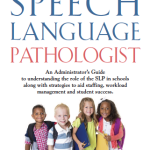SLP Chat
This will be a place where therapists can share ideas, problem solve and express concerns. Lets work together to make our jobs easier!
Teresa
Here come the high school years
I’ve been a little reflective this week. Last weekend my oldest son graduated from college on Saturday and my youngest son graduated from high school on Sunday. I found this article written in 2009, the year my youngest was a freshman in high school. It was written from the perspective of a parent who had gone through the process and a teacher who knew the types of schools kids were looking at. At the end of the article I wrote that I was a little sad not to have a middle schooler any more. I’m not sad at all that I don’t have a high schooler anymore. One reason is is that I know I have raised a confident and capable young man soon to be considered an adult. The other reason is no more private school payments! Imagine the possibilities!
Here Come The High School Years
Even though we are still in the dead of winter most middle schools around the country have already began preparing their 8th grade students and their parents for High School. In my district, they have already hosted a parent information night and visited the High School. Next week our students take their placement test. Most private High School and alternative High School applications were due in December and students are anxiously waiting to see if they get in. Moving on to high school is a big deal for these kids and most are ready to move on. However, I guarantee that most kids are thinking about what their social status will be in High School, not “am I going to be able to do the work or will I be successful?”
Students will enter high schools at a variety of different academic and maturity levels. High School placement tests are fairly good at placing students in the proper academic level. Public Schools will usually offer 2-3 different academic levels for students to enter. Private Schools will often offer 4-5 different academic levels. Parents need to understand that just because their middle schooler was an honor roll or even high honor roll student that does not automatically mean that the student is placed in the highest academic level. “A” work in middle school is very different than “A” work in high school. So don’t be too concerned about your child’s initial placement but do keep an eye on your student’s progress. You and your child will realize quickly if the work is too easy or too difficult. At that point, your child can speak to their teacher or guidance counselor about moving levels. Always let your child try to work things out on their own before intervening, it is high school after all.
By the end of 8th grade, kids are starting to feel really grown up. Parents occasionally seem to think it is the right time to back off completely. Don’t think they don’t need you because they do. They still need guidance, support and supervision in High School. What they don’t need is hovering. It is a fine line but you still need to know what your child is doing in school and how they are doing in school. Supervision after hours is just as important. They are experimenting with new friendships. Keep tabs on who their new friends are and don’t assume every parent has the same rules and values you do.
Homework becomes more important in high school. Usually a good percentage of a student’s grade is based on homework completion. If your school keeps grades on line, continue to check assignment completion, often. Your child should be doing some homework at home if they are not I would check in with teachers or review teacher expectations (usually provided as an outline). Some district might even have a homework policy. There is some controversy among teachers and administrators around homework. Let’s face it not all parents can do calculus or even algebra for that matter. We are probably all a little rusty on our French or Spanish. The controversy is that students do not go home on an even playing field where homework is concerned. However, by High School shouldn’t expectations be raised and shouldn’t students be more independent around homework? If your child is having difficulty academically in high school, encourage them to get help from their teachers before you step in. At the same time make sure they are doing the work.
I think it is important for all parents to have a basic idea of the school curriculum. You need to make sure of what they are taking and when they are taking it. If you have a child who receives special needs services it is a lot more important for you to be involved. You need to know exactly what your child is suppose to get, when the services take place, who will be providing the services and a direct contact person for any special needs concerns. Most schools will go out of their way to review programs and educational plans with parents of special needs students. If your child’s high school balks at this, pay even closer attention to their services. Any school I have ever been involved with as a Speech Language Therapist or as a parent has tried their best to design appropriate service plans, listen to students and parents and respond appropriately. Schools are not always perfect but remember you also have to work at developing a good working relationship with them. Education plans should be ammended or updated to dovetail with the high school schedule.
Don’t be too worried about your baby going off to high school. They will probably be ok. It’s scary for us parents and I know I’ve been on pins and needles those first few days of high school…..just worrying and wondering if everything is ok. Rather glad I don’t have to go through that again. Try to know what is going on with your child. Keep talking to your high schooler even if they don’t want to. Find something you can both feel comfortable talking about or do together, and then sneak some serious discussions when you can. Let your child know your expectations for their academic performance and behavior in general. You don’t have to set expectations at an impossible or stress inducing level but set some expectations. I’ve seen one child through high school and off to college and enjoyed almost every minute of it.
The picture above is of my son’s 8th grade graduation last June. I no longer have a middle school student. A little sad I have to admit.
Daniel Pink on motivation TED talk
All administrators need to take a listen to this. I think you can learn something. This is one of the TED talks. If you don’t know who Daniel Pink it’s time you did. I recommend you also pick up a few of his books.
http://www.youtube.com/watch?v=rrkrvAUbU9Y&feature=relmfu
Teresa
Improve that lateral lisp-maybe it’s not so hard
In the 25+ years of being a Speech Language Pathologist, I’ve done my best to avoid students who need work on their lateral /s/**. Pawning them off on other therapists was always good ploy. It also helped that some of the school systems I worked with felt that if articulation did not effect school performance articulation was not addressed. So honestly if the lateral /s/ kids were out there, they were never brought to my attention. Now I’ve landed myself at a school that actually wants articulation therapy for their students.
Since I hadn’t really worked on articulation for years, I had to get creative. Last year I took an articulation workshop with Char Boshart. Guess what I learned? That articulation therapy hasn’t changed in 30 years. Many of the techniques and even the tools are the same. It was a nice refresher. One thing Ms. Boshart was big on was getting the mouth into a good rest position. Which is a good starting point for /r/ and /l/ but a little more invasive than I usually like to do. You have to understand this is tricky with older kids. Honestly, I’ve never seen much success with /r/ even with other therapists. I think it is a real speciality and you have to be comfortable with. Another new trend is shorter more frequent sessions. Now that makes sense, more supervised practice. The bigger challenge is getting teachers and administration on board with this. Missing teaching time even 5 minutes is a problem these days when test scores are such a priority.
Now for my lateral lisp student. I never thought I could get a good /s/ from a lateral in isolation but I did! I was easy. /s/ in general is produced like /t/. The tongue is basically in the same place. Have the student produce t-t-t-t-t-t-t then slide into /s/. I got that juicy tidbit during an internet search. Don’t know why that technique didn’t occur to me sooner.
So my 3rd grade student who has a lateral /s/ is on his way to changing his /s/ production. As I listen to him spontaneously read, his correct /s/ production is about 30% without any prompting. During therapy he tells me it’s hard but I think it’s him being a little dramatic. He is able to hear the difference in the sounds, feel the difference with placement and self correct with a reminder. He needs practice an investment, which will come with maturity. I predict he will eventually change his /s/ production complexly. Never thought I could get anyone to do that.
**A lateral lisp is where the air comes out of the sides of the tongue when producing /s/, rather than the front. A lateral lisp might also be called a “slushy /s/”
Use Comics to Develop Higher Order Language
How long has it been since you read a comic book or the funnies? Most people began reading them for fun when they were young tweeners and probably never thought much of it. If you ever analyzed the language use in most comic books and funnies you might realize that they can make excellent and natural higher order language learning tools.
Most of us developed higher order language so naturally that we didn’t even notice. Higher order language is basically the ability to use and understand synonyms, antonyms, homonyms, homographs, figurative expressions, dual meaning sentences, metaphors, similes, idioms, sarcasm and non-verbal messages that might contribute to meaning. Higher order language allows us to see the “big picture.” Without the ability to understand and mentally manipulate higher order language you are unable to play with language, completing crossword puzzles is painful and you have difficulty “getting” jokes. These are very right brain concepts.
Students with language disabilities, poor academic skills, poor hearing or limited life experiences often have difficulty acquiring higher order language skills. You will be able to pick these kids out easily. They are the kids who struggle with reading comprehension, don’t get jokes, misunderstand sarcasm, misinterpret social situations and may even have frequent disagreements with peers.
The language used in comic books or in the funnies encompasses many higher order language structures. In addition there is a picture component that will aid comprehension. Take Peanuts for example, the comic itself is from the point of view of the children. The author/genius Charles Schulz, used the language in the comic to make it funny, show emotion or even to make a political point. He used the children in the comic to make it cute and appeal to children. If you grew up in the United States, the first comics you probably read were Bazooka Joe. Part of the experience of Bazooka gum was (and still is) reading the comic. Bazooka Joe comics were used to tell a joke or provide wisdom. For many years the front page of the Sunday Funnies were graced by The Family Circus. Each week Dolly, Billy, Jeffy, and P.J. got into predicaments that were familiar in every family. The cartoonist Bill Keane often used synonyms, antonyms, homonyms, sarcasm and dual meaning language to get his message across and make his comic funny.
Gary Larson’s The Far Side wins the prize for the best usage of higher order language. These simple one cell cartoons combined with a few lines of written language speak volumes. Comics in general are a creative medium incorporating both written and picture messages. When parents read comics to their children it adds another layer of auditory learning.
As kids get older their tastes will change. Don’t freak out when your child asks to buy Mad Magazine. It’s rude and it’s crude but it is froth with higher order language and unfortunately humor that interests them. Some daily funnies tell an ongoing saga which can show conflict and encourage prediction. The beauty of comics is that even children with language deficits can grow in their comic maturity. They might however need increased explanation as to “why” something is funny. That makes great conversation at the family table.
So while you might want your children to read the classics (and they should) encourage a variety of reading material including comics. Comics can do just as much for their higher order language development and you both might get a laugh out of it too.
Teresa Sadowski MA/SLP-ccc
The School Speech Therapist
New York Times Opinion Piece “Confessions of a Bad Teacher”
I came across this article today in the NY Times. This is an article that hits a little too close to home for most of us. Administrators please read and give it some thought. If you are pro-active, logical, realistic and fair you won’t run into teacher evaluation problems.
Hearing health in children and adults
http://www.examiner.com/speech-pathology-in-boston/earbuds-proceed-with-caution
New article on Examiner focusing on proper use of earbuds to maintain good hearing health. You might want to consider bring this up at your school in May, as part of better speech and hearing month.
Teresa
Chronic Otitis Media and Risk of Reading Failure
This article was originally published in “Your Middle Schooler: A Unique Age” in 2008. I try to include information on hearing history in every evaluation I perform. Not just for curiosity but because I really feel early hearing history plays a significant roll in language development and “learning to listen”. Last time I asked audiologists were not supporting this correlation. I hope things have changed. Because it is not a big issue in audiology, I have a hard time getting most administrators to accept this as an issue. As long as the kids pass the school screening, life is good. If universal supports were put in place around hearing and acoustics in general imaging the problems that could be avoided.
WEDNESDAY, JANUARY 16, 2008
Chronic Otitis Media and Risk of Reading Failure
While this paper does not specifically pertain to Middle School Students, I would have to guess that approximately 60-70% of my middle school caseload, at any specific time, have a history of Chronic Otitis Media also known as ear infections. Many of these students also have associated reading difficulties or history of reading difficulties.
.
Chronic Otitis Media and Risk of Reading Failure
by Teresa Sadowski MA/SLP-ccc
May 2007
Having worked as a Speech Language Pathologist for over 20 years, it always amazes me the number of students on my caseloads, that have a history of chronic otitis media or a history of excessive fluid in the middle ear. Perhaps it is not that that unusual. Statistics show that 70% of children will have at least one bout of otitis media commonly known as an ear infection before the age of 3. For many children ear infections are a recurring problem. It would not matter what level I was working with. I can state with some certainty that at least 50% of my public school caseload at any given time had a significant history of fluctuating hearing loss early on due to fluid in the middle ear because of chronic ear infections or chronic allergies. Let me make some generalizations about these kids. During my preschool experience, the students usually presented with articulation difficulties, had trouble with rhyming, had trouble remembering the right words to songs and many of them always seemed one step behind when responding verbally. Preschoolers may still be dealing with occasional ear infections, effecting hearing acuity and requiring treatment. During my kindergarten through 5th grade experience, the underlying language issues demonstrated by these students developed into actual reading problems. Simple articulation errors usually resolved but difficulty with phonics emerge. These students usually receive additional support services, specific reading instruction and tutoring. Often even with specific reading instruction, these kids were slow to have any kind of success with reading. During grade school, hearing usually stabilizes but it is not unusual for these students to still suffer with an occasional ear infection or fluid filled ears (especially during allergy season). In middle school my students continue to struggle with reading, they can usually decode consonants but vowels might be a problem. Difficulties with reading comprehension become very obvious. Most also demonstrate poor fluency when they read. These students have not naturally acquired the higher level language skills such as understanding ambiguous and figurative language. Their overall vocabulary is weak. These are the kids who miss the nuances and subtleties in language, they don’t get the jokes and they are not very flexible with their own use of language.
So what is the common thread that keeps kids with chronic ear infections or chronic allergies from becoming proficient readers? The answer could be very simple. Both groups experience fluctuating hearing loss early on. Ear infections occur through out childhood but the incidence of ear infections actually peaks between 6 and 12 months of age. When a child has fluid in his middle ear sounds can become seriously muffled, high frequency sounds cannot be heard. As a result, kids might miss a lot of what is said to them or miss a lot of environmental sounds that convey meaning. When hearing is effected, sounds, words and sentences are easily missed and/or misunderstood. A baby or young child obviously can’t tell you what they are missing. They can’t ask you to repeat yourself. They can’t tell you they can’t hear you because background noise is too loud. Their hearing can fluctuate so much that we cannot figure out what they are missing or when. Children learn language through direct contact with others and through imitation. If their hearing is distorted, imagine how they might perceive individual sounds both speech and environmental. I have always felt that these babies and kids miss critical information or do not develop critical listening skills that in some way effects the development of language and later on development of reading/spelling/writing skills. Basically, they may have missed critical developmental periods where they are learning to listen to, learn about and discriminate phonemes or individual speech sound.
It is surprising that so little research has been done around the very common correlation between fluctuating hearing loss and difficulties acquiring reading skills. One very interesting study, completed by Dr. Heather Winskel, from the University of Western Sydney, Australia, found that if a child experiences a middle ear infection during the crucial first years of life, it may have long-term effects on subsequent language and literacy development. In her study, she compared two groups of 43 children between the ages of 6 and 8. One group had an early history of repeated episodes of otitis media and the control group was matched for age, gender and socio-economic status. Children were tested on three different linguistic levels – phonological awareness, semantic knowledge and narration and reading ability. The children with a history of ear infections tended to achieve lower scores on phonological awareness skills of alliteration, rhyme and non-word reading, semantic skills of expressive vocabulary and word definitions and reading compared to non-otitis media children. Research agrees strongly that phonological awareness or phonemic awareness is a necessary skill that children need to begin reading. Could poor development of phonemic awareness be the key factor why children with a history of fluctuating hearing have difficulty learning to read naturally, using traditional methods?
So what is phonological or phonemic awareness? Scholars differ on what exactly to call it, but it is the same thing, here we will use the term phonemic awareness. Phonemic awareness is the ability to identify individual sounds and their order within words, underlies self-correction in word attack, word recognition and spelling: the ability to go from whole to the parts (Lindamood and Lindamood 1998). Phonemic awareness is not only correlated with learning to read, but research indicates a stronger statement is true: phonological awareness appears to play a causal role in reading acquisition. Phonological awareness is a foundational ability underlying the learning of spelling-sound correspondences (Stanovich, 1993-94). Basically, phonological or phonemic awareness is the ability to identify the sounds in words, not the letters but the sounds. For most of us, we acquired this skill so naturally we did not know we were doing it or we have practiced this skill for so many years it is second nature. Phonemic awareness develops long before our ability to put sounds and letters together. Adams in 1990 described 5 levels of honemic awareness in terms of abilities:
to hear rhymes and alliteration as measured by knowledge of nursery rhymes
to do oddity tasks (comparing and contrasting the sounds of words for rhyme and alliteration)
to blend and split syllables
to perform phonemic segmentation (such as counting out the number of phonemes in a word)
to perform phoneme manipulation tasks (such as adding, deleting a particular phoneme and regenerating a word from the remainder).
Scholars will also differ slightly on the levels of phonemic awareness or use different words to describe each level but they all pretty much agree that rhyming is when children show initial phonemic awareness. As a speech language pathologist, I would have to differ saying phonemic awareness begins much earlier. I believe phonemic awareness begins when the child begins to recognize and acquire sounds in their native language. However, when any of the 5 levels of phonemic awareness mentioned above are not achieved, reading difficulties are sure to develop. In some students, this can be so obvious that specific testing is just to confirm what the specialist already knows.
One reason why educators are so interested in phonemic awareness is that research indicates that it is the best predictor of the ease of early reading acquisition (Stanovich, 1993-94), better even than IQ, vocabulary and listening comprehension. This is a very interesting statement and echoed often in various research. What can be done to aid reading acquisition in children with fluctuating hearing loss? First of all children who suffer with chronic ear infections and chronic seasonal allergies should be considered at risk for reading failure and monitored closely. Parents should consult with early intervention or local public preschool to make sure developmental milestones are reached at the proper time. Public Schools also recommend and provide assessment in all learning and language areas. A full hearing evaluation by a licensed audiologist is essential. However, be aware a one time hearing evaluation can not predict how hearing may fluctuate or what the child is missing at any specific time. While a pediatrician will treat a child during an ear infection, if a child has chronic ear infections or fluid filled ears it is in the child’s best interest to consult a specialist. An Otolaryngologist (ear nose and throat doctor) along with the audiologist can determine how much fluid is in the ears, keeping the ear drum from moving efficiently. Depending on the situation, the Otolaryngologist may recommend the insertion of Pressure Equalization tubes through the ear drum. It is a very common procedure to help keep the middle ear fluid free. Without fluid in the middle hearing should return and remain consistent. When an early intervention or preschool child is identified as having difficulty developing speech and language, direct services are often recommended. A good therapist will present a variety of activities that “play with sounds and language” encouraging awareness and development of sounds and language while also focusing on specific needs. The speech therapist is often the first person to recognize that a child is at risk for reading difficulties.
Unfortunately, most reading difficulties are not identified and addressed until the student fails, usually the second half of first grade. Typical students easily acquire phonemic skills often without being specifically taught. They are ready to learn to read anywhere between 5 and 7 years of age. There are other developmental factors that determine whether a child is ready to learn reading so time might be given to see if a student can “catch up on their own”. This might be a good rule some of the time. However, if a student has a history of fluctuating hearing loss and has not developed phonemic awareness, reading is not going to emerge on its own. I do not have a lot of experience with reading programs but I have noticed that traditional reading programs do not always work for children who have deficits with phonemic awareness. These children do better with programs that use a multi-sensory approach and begin with a phonemic awareness component. The Lindamood Phoneme Sequencing Program (LIPS), uses a very strong multi-sensory phonemic awareness model. LIPS not only teaches the children to listen for the individual sounds it teaches the students how to feel the sounds and what the sounds look like. As the program, progresses the children are taught how to blend and break apart real and nonsense words. Teachers and specialists who are trained in this program and feel comfortable using it report wonderful successes for their students. My own child who has a history of fluctuating hearing did very well with a reading program called Project Read. I am less familiar with this program but remember it had a multi-sensory component that cued for sound and syllable production. Our local grade school uses Project Read with good results.
How does a parent know their child is developing appropriate phonemic awareness? There some very simple skills things to look for.
Awareness of Rhyming Words (age 3-4)Can your child….identify words that rhyme. For example, “Put your thumbs up if these two words rhyme, pail-tail or cow-pig?” or “Finish this rhyme, Red bed, blue ____.”
Awareness of Syllables (age 4-5)Can your child…..identify that words are made up of syllables. For example, “Can you clap and count the syllables or the word parts in rainbow?”
Awareness of Onsets and Rhymes-Sound Substitution (age 6)Can your child….identify onsets and rhymes in words. For example, “What rhymes with /at/ and begins with /f/?”
Sound Isolation – Awareness of Beginning, Middle and Ending Sounds (age 6)Can your child….Identify beginning, middle, and ending sounds in words. For example, “What is the beginning sound in neck?” “What is the ending sound in jog? “What sound do you hear in the middle of kitten?”
Phonemic Blending (age 6)Can your child….blend phonemes heard auditorily into a word. For example, after hearing /c/ /a/ /t/ said in a stretched pronunciation, the child says cat.
Phoneme Segmentation (age 6-7)Can your child….count the sounds in a word (age 6). For example, “How many sounds do you hear in the word dog?”Is able to identify the sounds heard in a word. For example, “What sounds do you hear in the word man?”
Phoneme Manipulation (Age 7+)Can your child omit or substitute phonemes to make new words. For example, “What word would we have if we changed the /t/ in Tommy to an /m/?” (mommy) or “What word would we have if we left out the /t/ in the middle of stand?” (sand)
Parents can provide their child with the ultimate “phonological” experience. If hearing loss of any kind is suspected, make sure parents know to have the child’s attention and look directly at the child when they speak. Provide children with lots of opportunities to listen and respond. This may sound simple but reading, learning, memorizing and reciting nursery rhymes and singing songs are excellent for developing phonemic awareness. Reading to children is also key to developing phonemic awareness. Keep background noise to a minimum. Do not keep the radio or TV on all the time. Parents should not be afraid to express their concerns to their pediatrician. Most pediatricians are not aware of the implications fluctuating hearing loss has in learning to read. Parents should seek out services through early intervention or your local public schools. Both agencies are required to screen and/or test students to determine if a disability exists.
Phonemic awareness is one of the first steps to success in reading. When a child has not developed efficient phonemic awareness because of fluctuating hearing early on, the risk of reading failure is very real. With the right intervention, involving multi-sensory tasks that focus on improving the child’s awareness of individual sounds and how they work together, these children have a better chance of becoming proficient readers.
Referances
Adams, Marilyn Jager (1990). Beginning to Read: Thinking and Learning about Print. Cambridge, MA: Bolt, Beranek, and Newman, Inc. ED 317 950
Lindamood, Patricia and Lindamood, Phyllis (1998). The Lindamood Phoneme Sequencing Program Teachers Manual. Austin TX. Pro-ed.
Sensenbaugh, Roger Phonemic Awareness: An Important Early Step in Learning To Read. THE EDUCATIONAL RESOURCES INFORMATION CENTER (ERIC). http://www.kidsource.com/kidsource/content2/phoemic.p.k12.4.html#contents
Stanovich, Keith E. (1993-94). “Romance and Reality (Distinguished Educator Series).” Reading Teacher, 47(4), 280-91. EJ 477 302
Winskel, Dr. Heather. Study reveals recurrent middle ear infections can have a major impact on children’s development. Research Australia. Feb 2007. http://www.eurekalert.org/pub_releases/2007-02/ra-srr020407.php
Los Angeles County Office of Education Website. Teams Educational Resources. Levels of Phonemic Awareness. http://teams.lacoe.edu/documentation/classrooms/patti/k-1/teacher/assessment/levels.html
Tell Me More About AAPPSPA
What an acronym. After reading in forums I found out what this means American Academy of Private Practice in Speech Pathology and Audiology. Their site looks professional and the group seems to have a lot to offer. Does anyone out there belong? Is this an organization worth joining? Reasonable rates.
Teresa
I received this response to my question when I posed it on ASHA forums….Thanks Denise
ASHA CE Administrator for AAPPSPA
Out of Range Testing for Severely Involved Students
Paula Stone,M.S.,C.C.C.-SLP wrote:
I would like to spend time discussing evaluation procedures for children who are severe to profound but chronologically are beyond the PLS 5.
Thank you for considering this important discussion.
Evaluating severely involved children who are below age ranges for test measures is extremely difficult. Being in the public schools we do run across this every so often. I can only tell you what I do. I’m not familiar with the Preschool Language Scale 5 but I do remember how the old PLS worked. I think you should be able to apply some of the information below. If there is anyone else out there who works in a setting where most of the kids are severe to profound in their development please add in your information. Especially if there are language scales out there that work well with severely language impaired children.
My experience is primarily with low functioning, low IQ kids. However, I found one past evaluation where I had to be very creative. School systems are often very limited with their variety of testing materials.
- In general, these evaluations will end up being very narrative. You will have to constantly watch the student’s behavior and manner of performance. You will have to comment on almost everything.
- You will not be able to report standard scores. If a test has age scores I will reluctantly report those. However, I will explain why standard scores can not be presented
- If the student is able to attend and point, I like to start with the Peabody Picture Vocabulary Test (PPVT) and (EVT). I actually like all my students to have a PPVT and an EVT. I think these tests combined with manner of performance gives a lot of information. Plus there is a huge age range, making it easy to compare performance from year to year or every three years.
- You can use tests like the PLS or the Test of Auditory Comprehension of Language (TACL) as checklists, describing what the kids can and cannot do. I’ve actually taken those tests and used the tasks mentioned to make a checklist to monitor performance. It isn’t ideal, might even be wrong to do this but it works and you have something to measure.
- A Language Sample works very well. You can determine Mean Length of Utterance, sentence structure, omissions, intent, topic maintenance and a whole host of other things. You’re going to have to use your tape recorder (now iphone) and transcribe the language sample then comment. Honestly this is where your clinical skills are put to the test.
- If your student is non-verbal you will have to describe how the child responds to language stimuli. If they work with a communication board try to incorporate that method.
- You may want to include an observation or how discuss how the student works in therapy.
- Evaluation might have to take place over several shorter sessions.
- Adding in some sort of pragmatic profile scale is also a good idea. With our low kids we are always teaching social skills. With younger kids the Clinical Evaluation Language Functions (CELF) probably isn’t the best choice. I am sure there are others out there.
- Every single one of these evaluations are going to look different.
This might not be the best way to evaluate severely involved kids but I work with what I have. Most school systems will just be happy that they don’t have to hire out for a speech and language evaluation. If they insist on standards explain the situation to them. They have two options hire out or buy the right testing materials. I’ve read outside evaluations on severely involved kids, from both hospitals and private vendors and I’ve yet to see an evaluation that is significantly better than what I generate. It’s challenging that’s for sure and it takes a lot more work. I’d love to hear what you have to say on the subject.
Below are two sample evaluations, hope they help out.
Teresa
Curriculum and Speech Therapy
I was recently asked by a new therapist, working at the middle school level, if I was able to use curriculum material in therapy. Over the years I found that it was very difficult to incorporate curriculum into therapy. So I guess my answer is no but with some clarifications and of course exceptions.
*Even though many would disagree with me, the speech pathologist is not there to teach academics. We are there to fill gaps. The SLP needs to focus on teaching underlying skills that aid independent learning and life skills. It is difficult to work on remediating language disabilities if we also have to address academics.
Last thoughts……It is important to have an idea of the basic curriculum. If a student asks for help with academics, try to drop everything, find out what they need and help them out. I know that if a student comes to me with an academic questions they are either struggling, confused or overwhelmed.










